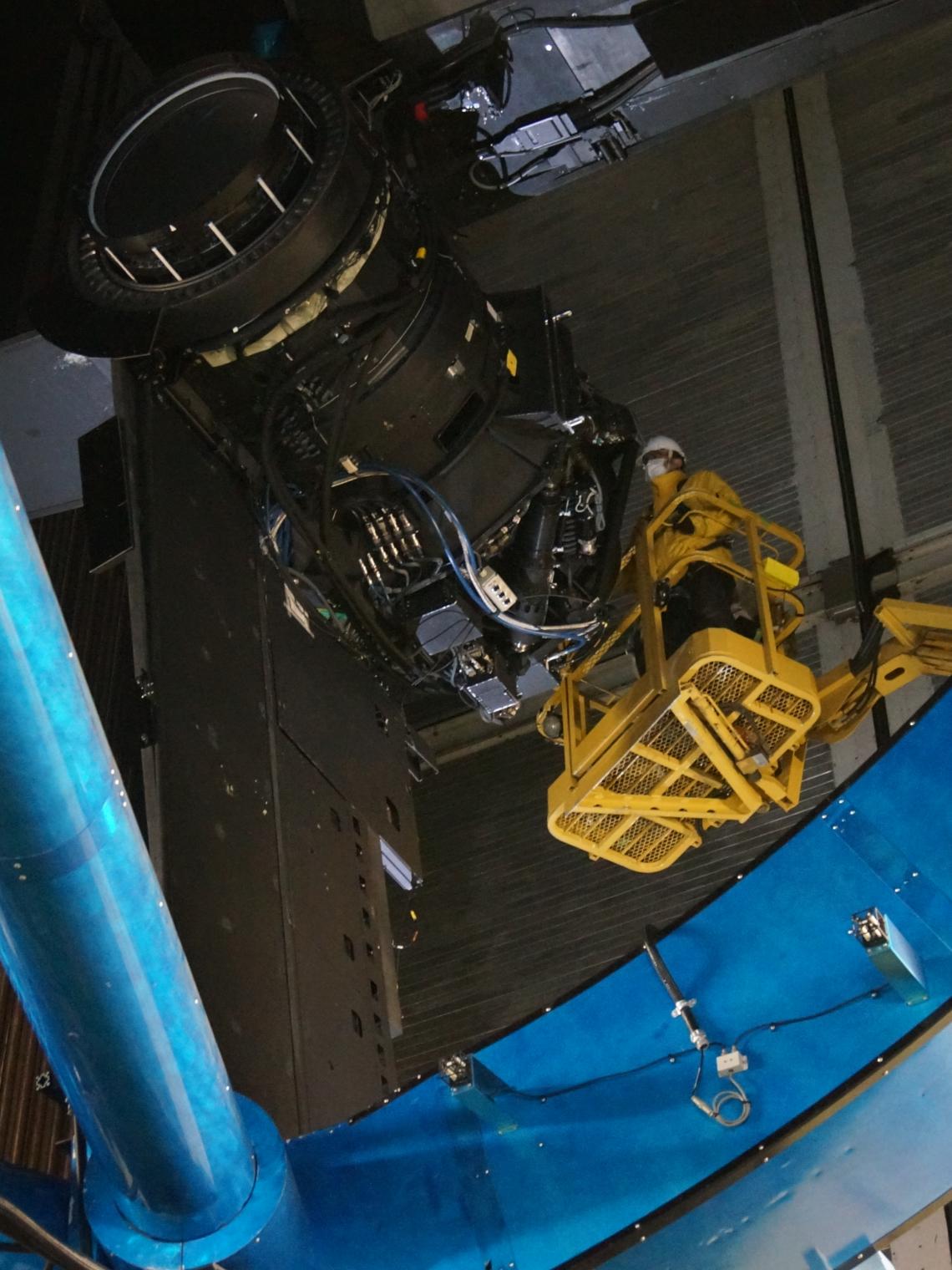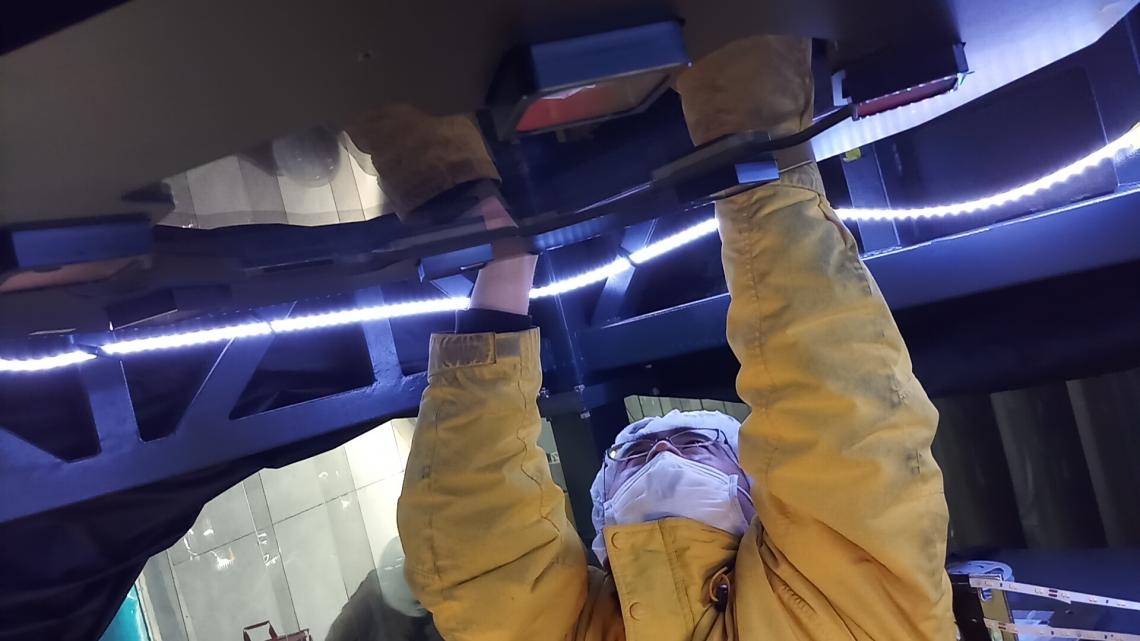View from the Subaru Telescope of broader landscape with Caltech Submillimeter Observatory.
This story is featured in the Asia Research News 2022 magazine. If you would like to receive regular research news, join our growing community.
Get the news in your inbox
Q: You’ve been up to Maunakea many times. What is it like?
A: I usually describe it as looking like Mars.
I was a graduate student the first time I went up. The air was so thin at 4,139 metres that I got altitude sickness. My head hurt and I lost my appetite. Eventually we made it down to the dormitories at 2,800 m above sea level, but because the air was still thin, I had trouble getting to sleep. Even after we made it back down to base, it took a while before I got my appetite back.
But even in those conditions, you have work to do and you still need to use your head. So those first trips were very challenging.
Since then, I make sure I have three things. First, I don’t feel well when I’m cold so I make sure I am wearing warm clothes. I also feel worse if I stay hungry, so I always pack a few snacks. When I get headaches, it’s not terrible but my eyes start to hurt and my vision can get blurry, so I always make sure I have a box of aspirin on me.
Did you know?
Maunakea is one of the best places for astronomical observations on Earth. For astronomers, minimal light pollution, high altitude, dry air, and a high percentage of clear nights produce the best results.
The Subaru Telescope resides in one of 12 world-renowned observatories on the summit of Maunakea, Hawaii.
Q: What does your typical workday look like on Maunakea?
A: I leave the base at Hilo by 8am and head by car to the dormitory on Maunakea at 2,800 m above sea level. There’s a half hour break there to acclimatize to the altitude. Once that is over, it is time to hop back into the car and drive up to the top of the mountain.
Our work hours vary depending on what needs to be done that day. In general, we arrive at the summit around 10am and leave by 4pm to give the team using the telescope at night time to get organized.
According to Tamura, working at a telescope has never been a 9 to 5 office job. The telescope's onsite staff can work for days leading up to a scheduled use to ensure that as many researchers as possible from around the world can carry out their observations at night. But that means all the maintenance and troubleshooting work on the telescope needs to be done during the day. That cuts into Tamura's time. Even though he is working on a next-generation science project, the work of other astronomers is equally important, and so Tamura alters his work schedule to fit in with the schedules of other researchers.
Because of these reasons, researchers spend much of their time at the base in the town of Hilo, which Tamura has been visiting one to three times a year these past few years. He has been overseeing the construction of a large scientific instrument, like completing a jigsaw puzzle. Over the past few years, his collaboration has been constructing and testing several components at their individual institutes: a prime focus instrument, a metrology camera system, four spectrographs and four fibre cables. Tamura says these individual components are like puzzle pieces, and putting them together on the Subaru Telescope will create something unique.
Q: What are you building up there?
A: The Subaru Telescope captures images of stars and galaxies in the night sky. We’re building a Prime Focus Spectrograph (PFS) that will split up the light from these celestial objects into their various wavelengths. This can reveal different details about an object, such as its motion. Once complete, the PFS will be able to process about 2,400 objects at once.
While the PFS is one of a kind in this sense, it is unique in that it will be used on an 8.2m telescope, unlike most of the others on much smaller ones. What Tamura is excited about is that once finished, the PFS will be able to collect information, or spectra, from a couple thousand celestial objects at once, taking advantage of the large light-gathering power of the telescope as well as the other competent capabilities of the PFS itself.
Kavli IPMU's Naoyuki Tamura has been working with researchers from more than 20 institutions to build the Prime Focus Spectrograph (PFS) on site at the Subaru Telescope.
Q: How far along are you?
A: Different parts of the PFS have been arriving to Hawaii since 2018. I would say we’re about 70% there. Bear in mind we will spend about a year testing and calibrating the equipment on site because there’s always something that doesn’t work quite as planned.
Q: So do you help put the instrument together?
A: Of course I’ll help with tightening the screws, but my role now is more to set priorities, decide what our goals are, and to make sure I keep an eye on how the entire project is progressing.
In my last project, I was working with researchers from three countries. Now the PFS has more than 20 collaborating organizations in seven countries, so it is a new experience for me.
This is a difficult task at this altitude. Altitude sickness affects the brain, and so it is easy to lose one’s judgement. Communication can easily break down. In this project, the researchers and engineers spend most of their time working in separate teams, developing individual pieces. I am the bridge that keeps them connected. On the mountain, teams must work together to get things done efficiently in the limited time frame, so coordination and bridging are quite important.
Q: How has COVID-19 affected work?
A: The pandemic has made things difficult. Early in the pandemic, the rules changed to allow only two people to ride together in a car, making it time-consuming to get everyone on site.
Teams usually transport equipment from their home countries to Hawaii by plane, and then they are loaded onto a truck and taken to Hilo first for a check-up or directly to the summit of Maunakea. During the early stages of the pandemic there were fewer cargo flights and higher transportation costs. At one point, a flight that was supposed to carry a piece of equipment from Honolulu to Hilo was rescheduled, but the equipment’s tall crate couldn’t fit into the hull of the rescheduled plane, so the researchers had to transport the piece to Hilo by ship.
Q: You have been up there so many times, has the scene changed to you?
A: I’ve been up many times, so it has become a familiar sight. But the sky is so close. This is true no matter whether it is day or night.
Further information
Assoc Prof Naoyuki Tamura | [email protected]
Kavli Institute for the Physics and Mathematics of the Universe
The University of Tokyo
Read the article in Asia Research News 2016 on early plans for PFS to uncover clues about the nature of dark matter, dark energy, galaxy formation and evolution.
We welcome you to reproduce articles in Asia Research News 2022 provided appropriate credit is given to Asia Research News and the research institutions featured.






